chapter 11- endocrine glands and hormones
1/58
There's no tags or description
Looks like no tags are added yet.
Name | Mastery | Learn | Test | Matching | Spaced |
|---|
No study sessions yet.
59 Terms
How do hormones function in physiological regulation?
They act as chemical messengers, binding to receptors on target tissues to regulate metabolism, growth, development, and homeostasis
What are synergistic, permissive, and antagonistic effects of hormones?
Synergistic: Combined effect > individual effects (e.g., glucagon + epinephrine on glucose).
Permissive: One hormone enables another’s full effect (e.g., thyroid hormone allows epinephrine to release fatty acids).
Antagonistic: Opposing effects (e.g., insulin ↓ glucose vs. glucagon ↑ glucose)
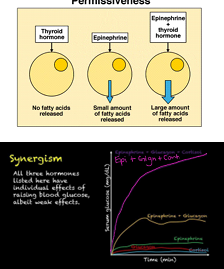
How do hormones act on target cells?
By binding to membrane-bound or intracellular receptors, producing a response.
How are hormone responses regulated or shut off?
By antagonistic hormones or negative feedback pathways within target cells.
Which glands regulate most of the endocrine system?
The hypothalamus and pituitary gland.
What is the embryonic origin of the anterior pituitary?
Endoderm-derived. (endocrine glands)
What hormones are secreted by the anterior pituitary?
Growth hormone (GH)
Adrenocorticotropic hormone (ACTH)
Thyroid stimulating hormone (TSH)
Follicle stimulating hormone (FSH)
Luteinizing hormone (LH)
Melanocyte stimulating hormone (MSH)
Prolactin (PRL)
What is the embryonic origin of the posterior pituitary?
Ectoderm-derived.(a nervous system origin)
What neurohormones are secreted by the posterior pituitary?
Antidiuretic hormone (ADH)
Oxytocin (OT)
What is a permissive effect of hormones?
When the first hormone is required for the full effect of a second hormone.
Example of a permissive hormone interaction?
Thyroid hormone is permissive for epinephrine(adrenaline) in releasing fatty acids. Epinephrine alone causes only a small release, but with thyroid hormone, a large release occurs.
What is a synergistic effect of hormones?
When two or more hormones together produce a greater effect than each hormone alone.
Example of synergistic hormone interaction?
Epinephrine, glucagon, and cortisol all increase blood glucose slightly when acting alone, but together their effect is much stronger (synergistic).
What are antagonistic effects of hormones?
When two hormones produce opposite effects on the same regulated variable.
Classic example of antagonistic hormones?
Insulin and glucagon regulate blood glucose in opposite ways.
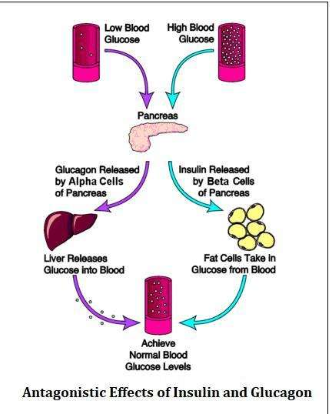
How does glucagon act when blood glucose is low?
Released from pancreatic alpha cells → stimulates the liver to release glucose into the blood.
How does insulin act when blood glucose is high?
Released from pancreatic beta cells → stimulates glucose uptake by cells (including adipose tissue) → lowers blood glucose.
Why are antagonistic hormones important?
They help maintain homeostasis by keeping plasma glucose within normal ranges to ensure a constant energy supply for brain cells.
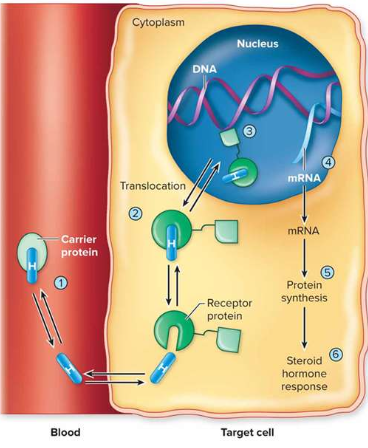
What are steroid hormones and how do they act?
Lipid-soluble hormones made from cholesterol; they cross cell membranes, bind intracellular receptors, and regulate gene expression through protein synthesis.
How fast do steroid hormones act, and do they use signal amplification?
Responses take hours to days; no signal amplification (effect depends on hormone amount).
Give examples of steroid hormones.
Aldosterone, cortisol, testosterone, estrogen, progesterone, calcitriol, T3, T4.
What are nonsteroid hormones and how do they act?
Water-soluble hormones that bind to membrane receptors; they use second messengers (cAMP, IP₃, Ca²⁺, tyrosine kinase) to regulate chemical reactions in target cells.
How fast are nonsteroid hormone responses, and do they use amplification?
Very rapid (seconds to minutes); they use signal amplification for strong effects from small amounts.
Give examples of nonsteroid hormones.
ADH, oxytocin, insulin, glucagon, ACTH, FSH, LH, PTH, TSH.
Why must hormone effects be tightly regulated?
To prevent overstimulation of target tissues and maintain homeostasis.
What are the main ways hormone effects are limited?
Secreting small amounts of hormone
Negative feedback
Removing or inactivating circulating hormone (enzyme degradation, excretion)
Why is signal amplification important in regulation?
Target cells need only small amounts of hormone to trigger strong responses, which allows secretion of minimal hormone levels while still being effective.
How are hormones inactivated after their job is done?
Enzymes degrade them into inactive products, which can then be excreted in urine.
How can hormone responses be shut off at the receptor level?
By regulating receptors through receptor-mediated endocytosis, followed by lysosome-mediated degradation, which terminates hormone activity inside target cells.
What is “half-life” in hormone regulation?
The amount of time it takes for plasma hormone levels to decrease by half.
Why is half-life important?
It indicates how long a hormone remains active. Hormones with longer half-lives (e.g., cortisol 60–90 min, steroid hormones several hours) produce longer responses, while those with shorter half-lives (e.g., epinephrine 2–3 min) have brief effects.
What is a trophic hormone?
A hormone that targets another endocrine gland and stimulates secretion of its hormones (e.g., ACTH → adrenal cortex).
What are the main adrenal cortex hormones and their functions?
Aldosterone (mineralocorticoid): Na⁺ retention, K⁺ excretion, BP regulation.
Cortisol (glucocorticoid): ↑ glucose, fat breakdown, ↓ immune response.
Androgens: Minor sex hormones
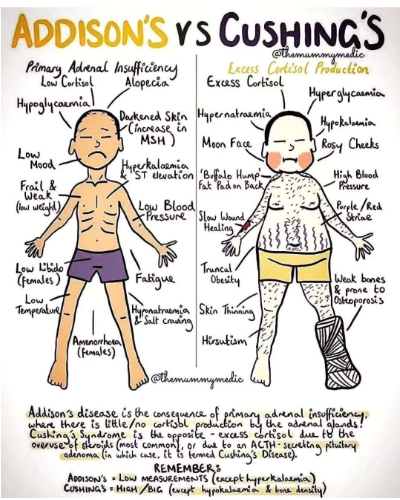
What disorders involve adrenal hormone imbalance?
Cushing’s syndrome: Hypercortisol → high glucose, fat redistribution.
Addison’s disease: Hypocortisol/aldosterone → low BP, hypoglycemia, electrolyte imbalance
Which hormones are released in response to stress?
Cortisol, epinephrine, and CRH.
What are the effects of chronic stress (excess cortisol and epinephrine)?
Cortisol can affect brain regions → depression, anxiety, impaired short-term memory.
Cortisol increases liver glucose release → may cause insulin resistance → worsens diabetes.
What are the main functions of thyroid hormones (T₃ and T₄)?
They regulate metabolic rate and activity, fetal development, body temperature, gametogenesis, muscle contraction, heart rate, and mitosis.
What is the function of calcitonin?
Lowers plasma calcium levels by inhibiting calcium absorption in intestines, reducing calcium reabsorption in kidneys, and promoting calcium storage in bones.
Which hormone is antagonistic to calcitonin, and what does it do?
Parathyroid hormone (PTH), which raises plasma calcium levels by stimulating bone resorption, kidney reabsorption, and intestinal absorption of calcium.
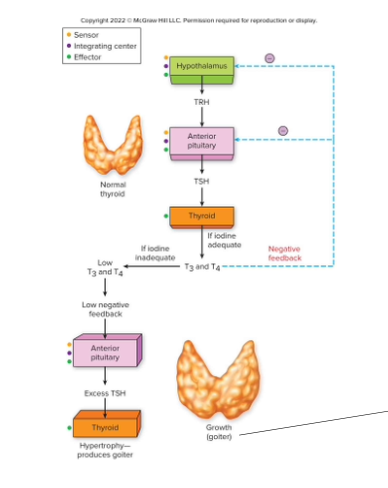
How are thyroid hormones (T₃ and T₄) regulated?
TRH (hypothalamus) → TSH (anterior pituitary) → T₃ and T₄ (thyroid). T₃/T₄ then exert negative feedback on TRH and TSH to maintain balance.
Why is iodine important in thyroid hormone regulation?
T₃ and T₄ require iodine; without enough iodine, negative feedback fails, leading to excess TSH and thyroid enlargement (goiter).
What is Grave’s disease?
An autoimmune disorder in which autoantibodies bind to TSH receptors on thyroid follicular cells, causing the thyroid to enlarge (goiter) and overproduce thyroid hormones (hyperthyroidism).
What is a common visible symptom of Grave’s disease?
Exophthalmos – bulging eyes due to inflammation and swelling of the tissues and fat behind the eyes.
What is hypothyroidism?
A condition of low thyroid hormone levels (T₃ and T₄).
What are the three possible levels of hypothyroidism?
Primary: Thyroid gland dysfunction.
Secondary: Pituitary-level problem.
Tertiary: Hypothalamus-level problem.
How is hypothyroidism usually treated?
With hormone replacement therapy.
Where are the parathyroid glands located?
On the dorsal (posterior) side of the thyroid gland — 2 superior and 2 inferior patches of parathyroid cells.
What are the actions of parathyroid hormone (PTH)?
Increases plasma calcium by:
Releasing calcium from bones
Promoting intestinal absorption of calcium
Increasing calcium reabsorption in kidneys
What are the actions of calcitonin?
Lowers plasma calcium by:
Inhibiting intestinal absorption
Inhibiting kidney reabsorption (more Ca²⁺ excreted)
Promoting calcium storage in bones
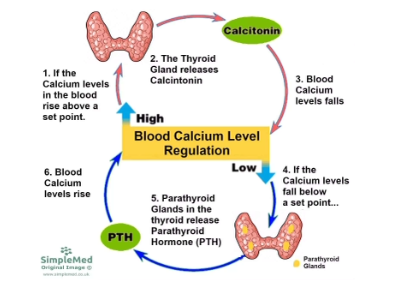
How do PTH and calcitonin interact?
They are antagonistic hormones, working in nearly perfect opposition to regulate calcium homeostasis.
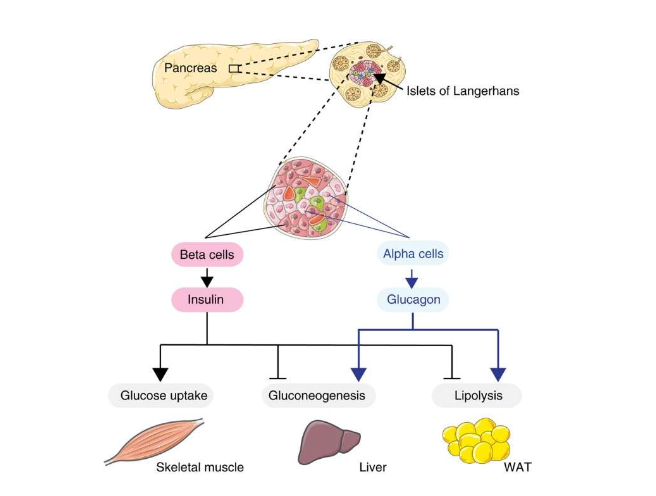
Which cells produce insulin and glucagon?
Insulin: Pancreatic beta cells
Glucagon: Pancreatic alpha cells
What is the main function of insulin?
Lowers blood glucose (BGL) by promoting uptake of glucose into liver, muscle, and adipose cells via GLUT4 transporters. Glucose is then used for ATP, stored as glycogen, or stored as fat.
What is the main function of glucagon?
Raises blood glucose by stimulating glycogen breakdown, gluconeogenesis (new glucose synthesis in liver), ketone release, and fatty acid release from adipose tissue.
What diseases/disorders affect insulin and glucagon regulation?
Type 1 diabetes: insufficient insulin production.
Type 2 diabetes: insulin resistance or inadequate insulin secretion.
Chronic high glucose → symptoms like excessive urination/thirst, vision problems, slow-healing wounds, neuropathy.
What is melatonin and where is it secreted from?
A small amino acid hormone secreted by the pineal gland, involved in regulating circadian rhythms.
What disorders are associated with melatonin?
Jet lag and seasonal affective disorder (SAD).
What are prostaglandins and how are they produced?
Small signaling molecules derived from plasma membrane phospholipids; produced by almost all cells.
Describe the function of melatonin from the pineal gland.
regulates circadian rhythms and sleep-wake cycles. Its secretion is inhibited by light and stimulated by darkness. It promotes sleep onset, relaxation, and also has antioxidant, anti-inflammatory, and anti-hypertensive effects. It is associated with jet lag and seasonal affective disorder. SAD
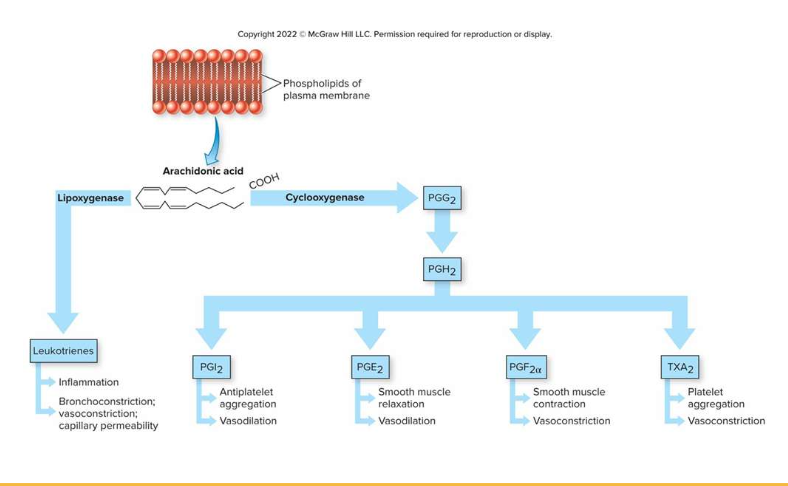
Describe six distinct functions of prostaglandins as paracrine/autocrine regulators.
Immune system: Promote inflammation, pain, and fever.
Reproductive system: Aid ovulation, corpus luteum function, and uterine contractions.
Digestive system: Inhibit gastric secretion; stimulate propulsion and absorption.
Respiratory system: Aid bronchodilation and bronchoconstriction.
Circulatory system: Regulate vasoconstriction/dilation and blood clotting.
Urinary system: Increase blood flow to kidneys, enhancing urine excretion.